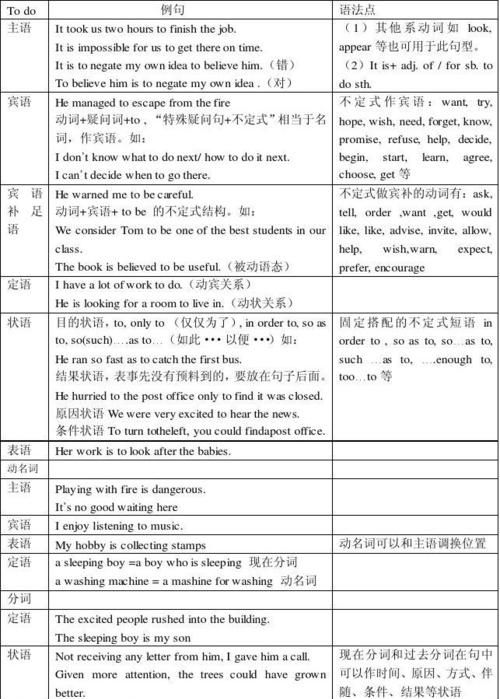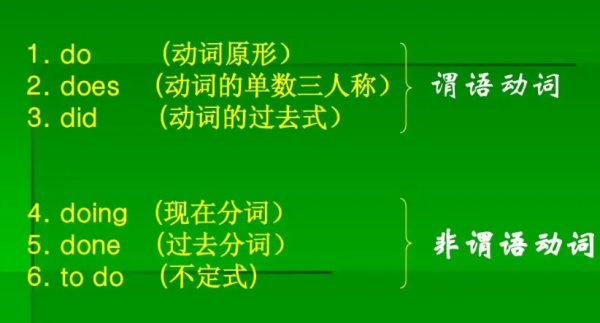本文目录
动名词现在分词作非谓语区别
你好,动名词侧重于名词,你可以把它当做一个名词,既然靠近名词,那么表达的是一种概念。
例句:I like swimming.(这里游泳是动名词,不是“正在游泳”,而是一种概念)
我喜欢游泳。
现在分词侧重于动作,表示正在做某事。
例句:I am swimming.(这里游泳是现在分词,侧重于动作,正在做某事)
我正在游泳。
如果还有其他英语方面的问题可以在weibo上问我,我的weibo是 英语小张

非谓语动词是什么?
在英语中,不作句子谓语,而具有除谓语外其他语法功能的动词,叫做非谓语动词。非谓语动词有动词不定式(the Infinitive);动名词(the Gerund);现在分词(the Present Participle);过去分词(the Past Participle)。
1.非谓语动词与谓语动词的相同点有:
(1)如果是及物动词都可与宾语连用,例如:
They built a garden.
They suggested building a garden.
(2)都可以被状语修饰:
The suit fits him very well.
The suit used to fit him very well.
(3)都有主动与被动, “体”式(一般式;进行式;完成式)的变化。例如:
He was punished by his parents.(谓语动词被动语态)
He avoided being punished by his parents.(动名词的被动式)
We have written the composition.(谓语动词的完成时)
Having written the composition, we handed it in.(现在分词的完成式)
(4)都可以有逻辑主语
They started the work at once.(谓语动词的逻辑主语)
The boss ordered them to start the work.(动词不定式的逻辑主语)
We are League members.(谓语动词的主语)
We being League member, the work was well done.
(现在分词的逻辑主语)
2、非谓语动词与谓语动词的不同点有:
(1)非谓语动词可以有名词作用(如动词不定式和动名词),在句中做主语、宾语、表语。
(2)非谓语动词可以有形容词作用(如动词不定式和分词),在句中做定语、表语或宾语补足语。
(3)非谓语动词可以有副词作用(如动词不定式和分词),在句中作状语。
(二)非谓语动词的句法功能:
二、非谓语动词用法:
(一)动词不定式:(to)+do,具有名词、形容词、副词的特征。
1.不定式的形式:(以动词write为例)
否定式:not + (to) do
(1)一般式:不定式的一般式所表示的动作与谓语动词动作同时发生或发生在谓语动词动作之后,
例如:
I'm glad to meet you.
He seems to know a lot.
We plan to pay a visit.
He wants to be an artist.
The patient asked to be operated on at once.
The teacher ordered the work to be done.
(2)进行式:不定式的进行式所表示的动作与谓语动词动作同时发生,例如:
The boy pretended to be working hard.
He seems to be reading in his room.
(3)完成式:不定式的完成式表示的动作发生在谓语动词动作之前,例如:
I regretted to have told a lie.
I happened to have seen the film.
He is pleased to have met his friend.
2.不定式的句法功能:
(1)作主语:
To finish the work in ten minutes is very hard.
To lose your heart means failure.
动词不定式短语作主语时,常用it作形式主语,例如上面两句可用如下形式:
It is very hard to finish the work in ten minutes.
It means failure to lose your heart.
(2)作表语:
Her job is to clean the hall.
He appears to have caught a cold.
(3)作宾语:
常与不定式做宾语连用的动词有:want, hope, wish, offer, fail, plan, learn, pretend, refuse, manage, help, agree, promise, prefer, 如果不定式(宾语)后面有宾语补足语,则用it作形式宾语,真正的宾语(不定式)后置,放在宾语补足语后面,例如:
Marx found it important to study the situation in Russia.
动词不定式也可充当介词宾语,如:
I have no choice but to stay here.
He did nothing last Sunday but repair his bike.
动词不定式前有时可与疑问词连用,如:
He gave us some advice on how to learn English.
(4)作宾语补足语:
在复合宾语中,动词不定式可充当宾语补足语,如下动词常跟这种复合宾语:want, wish, ask, tell, order, beg, permit, help, advise, persuade, allow, prepare, cause, force, call on, wait for, invite.
此外,介词有时也与这种复合宾语连用,如:
With a lot of work to do, he didn't go to the cinema.
有些动词如make, let, see, watch, hear, feel, have等与不带有to的不定式连用,但改为被动语态时,不定式要加to, 如:
I saw him cross the road.
He was seen to cross the road.
(5)作定语:
动词不定式作定语,放在所修饰的名词或代词后。与所修饰名词有如下关系:
①动宾关系:
I have a meeting to attend.
注意:不定式为不及物动词时,所修饰的名词如果是地点、工具等,应有必要的介词,如:
He found a good house to live in.
The child has nothing to worry about.
What did you open it with?
如果不定式修饰time, place, way,可以省略介词:
He has no place to live.
This is the best way to work out this problem.
如果不定式所修饰名词是不定式动作承受者,不定式可用主动式也可用被动式:
Have you got anything to send?
Have you got anything to be sent?
②说明所修饰名词的内容:
We have made a plan to finish the work.
③被修饰名词是不定式逻辑主语:
He is the first to get here.
(6)作状语:
①表目的:
He worked day and night to get the money.
She sold her hair to buy the watch chain.
注意不定式放句首时,逻辑主语与句子主语要一致:
wrong:To save money, every means has been tried.
right:To save money, he has tried every means.
wrong:To learn English well, a dictionary is needed.
right:To learn English well, he needs a dictionary.
②表结果:
He arrived late to find the train gone.
常用only放在不定式前表示强调:
I visited him only to find him out.
③表原因:
They were very sad to hear the news.
④表程度:
It's too dark for us to see anything.
The question is simple for him to answer.
(7)作独立成分:
To tell you the truth, I don't like the way he talked.
(8)不定式的省略:保留to省略do动词。
If you don't want to do it, you don't need to.
(9)不定式的并列:第二个不定式可省略to。
He wished to study medicine and become a doctor.
(二)动名词:
动名词既具有动词的一些特征,又具有名词的句法功能。
1.动名词的形式:
否定式:not + 动名词
(1)一般式:
Seeing is believing. 眼见为实。
(2)被动式:
He came to the party without being invited.他未被邀请就来到了晚会。
(3)完成式:
We remembered having seen the film. 我们记得看过这部电影。
(4)完成被动式:
He forgot having been taken to Guangzhou when he was five years old.
他忘记五岁时曾被带到广州去过。
(5)否定式:not + 动名词
I regret not following his advice. 我后悔没听他的劝告。
(6)复合结构:物主代词(或名词所有格)+ 动名词
He suggested our trying it once again. 他建议我们再试一次。
His not knowing English troubled him a lot.
他不懂英语给他带来许多麻烦。
2.动名词的句法功能:
(1)作主语:
Reading aloud is very helpful. 朗读是很有好处的。
Collecting stamps is interesting. 集邮很有趣。
当动名词短语作主语时常用it作形式主语。
It's no use quarrelling.争吵是没用的。
(2)作表语:
In the ant city, the queen's job is laying eggs.
在蚂蚁王国,蚁后的工作是产卵。
(3)作宾语:
They haven't finished building the dam. 他们还没有建好大坝。
We have to prevent the air from being polluted.
我们必须阻止空气被污染。
注意动名词既可作动词宾语也可作介词宾语,如上面两个例句。此外,动名词作宾语时,若跟有宾语补足语,则常用形式宾语it,例如:
We found it no good making fun of others. 我们发现取笑他人不好。
要记住如下动词及短语只跟动名词作宾语:
enjoy, finish, suggest, avoid(避免), excuse ,delay, imagine, keep, miss, consider, admit(承认),deny(否认), mind, permit, forbid, practise, risk(冒险), appreciate(感激), be busy, be worth, feel like, can't stand, can't help(情不自禁地), think of, dream of, be fond of, prevent…(from),keep …from, stop…(from),protect…from, set about, be engaged in, spend…(in), succeed in, be used to, look forward to, object to, pay attention to, insist on, feel like
(4)作定语:
He can't walk without a walking-stick. 他没有拐杖不能走路。
Is there a swimming pool in your school? 你们学校有游泳池吗?
(5)作同位语:
The cave, his hiding-place is secret. 那个山洞,他藏身的地方很秘密。
His habit, listening to the news on the radio remains unchanged.
他收听收音机新闻节目的习惯仍未改变。
(三)现在分词:
现在分词既具有动词的一些特征,又具有形容词和副词的句法功能。
1、现在分词的形式:
否定式:not + 现在分词
(1)现在分词的主动语态:现在分词主动语态的一般式表示与谓语动词所表示的动作同时发生,完成
式表示的动作在谓语动词所表示的动作之前发生,常作状语。例如:
They went to the park, singing and talking. 他们边唱边说向公园走去。
Having done his homework, he played basket-ball. 做完作业,他开始打篮球。
(2)现在分词的被动语态:一般式表示与谓语动词同时发生的被动的动作,完成式表示发生在谓语动
词之前的被动的动作。
The problem being discussed is very important. 正在被讨论的问题很重要。
Having been told many times, the naughty boy made the same mistake.
被告诉了好几遍,这个淘气的孩子又犯了同一个错误。
2.现在分词的句法功能:
(1)作定语:现在分词作定语,当分词单独做定语时,放在所修饰的名词前;如果是分词短语做定语
放在名词后。
In the following years he worked even harder.
在后来的几年中,他学习更努力了。
The man speaking to the teacher is our monitor's father.
正与老师谈话的那个人是我们班长的父亲。
现在分词作定语相当于一个定语从句的句法功能,如:in the following years也可用in the years that followed; the man speaking to the teacher可改为the man who is speaking to the teacher.
(2)现在分词作表语:
The film being shown in the cinema is exciting. 正在这家上演的电影很棒。
The present situation is inspiring. 当前的形势鼓舞人心。
be + doing既可能表示现在进行时,也可能是现在分词做表语,它们的区别在于be + doing表示进行的动作是进行时,而表示特征时是系动词be与现在分词构成系表结构。
(3)作宾语补足语:
如下动词后可跟现在分词作宾语补足语:
see, watch, hear, feel, find, get, keep, notice, observe, listen to, look at, leave, catch等。例如:
Can you hear her singing the song in the next room? 你能听见她在隔壁唱歌吗?
He kept the car waiting at the gate. 他让小汽车在门口等着。
(4)现在分词作状语:
①作时间状语:
(While) Working in the factory, he was an advanced worker.
在工厂工作时,他是一名先进工人。
②作原因状语:
Being a League member, he is always helping others. 由于是共青团员,他经常帮助他人。
③作方式状语,表示伴随:
He stayed at home, cleaning and washing. 他呆在家里,又擦又洗。
④作条件状语:
(If) Playing all day, you will waste your valuable time.
要是整天玩,你就会浪费宝贵的时间。
⑤作结果状语:
He dropped the glass, breaking it into pieces. 他把杯子掉了,结果摔得粉碎。
⑥作目的状语:
He went swimming the other day. 几天前他去游泳了。
⑦作让步状语:
Though raining heavily, it cleared up very soon.
虽然雨下得很大,但不久天就晴了。
⑧与逻辑主语构成独立主格:
I waiting for the bus, a bird fell on my heard.
我等汽车时,一只鸟落到我头上。
All the tickets having been sold out, they went away disappointedly.
所有的票已经卖光了,他们失望地离开了。
Time permitting, we'll do another two exercises.
如果时间允许,我们将做另两个练习。
有时也可用with (without) +名词(代词宾格)+分词形式
With the lights burning, he fell asleep. 他点着灯睡着了。
⑨作独立成分:
udging from(by) his appearance, he must be an actor.
从外表看,他一定是个演员。
Generally speaking, girls are more careful. 一般说来,女孩子更细心。
(四)过去分词:
过去分词只有一种形式:规则动词由动词原形加词尾-ed构成。不规则动词的过去分词没有统一的规则要求,要一一记住。
过去分词的句法功能:
1.过去分词作定语:
Our class went on an organized trip last Monday. 上周一我们班开展了一次有组织的旅行。
Those elected as committee members will attend the meeting. 当选为委员的人将出席这次会。
注意当过去分词是单词时,一般用于名词前,如果是过去分词短语,就放在名词的后面。过去分词做定语相当于一个被动语态的定语从句。
2.过去分词作表语:
The window is broken. 窗户破了。
They were frightened at the sad sight. 他们对眼前悲惨的景象感到很害怕。
注意:be + 过去分词,如果表示状态是系表结构,如果表示被动的动作是被动语态。区别:
The window is broken.(系表)
The window was broken by the boy.(被动)
有些过去分词是不及物动词构成的,不表示被动,只表示完成。如:
boiled water(开水) fallen leaves(落叶)
newly arrived goods(新到的货) the risen sun(升起的太阳)
the changed world(变了的世界)
这类过去分词有:gone, come, fallen, risen, changed, arrived, returned, passed等。
3.过去分词作宾语补足语:
I heard the song sung several times last week.
上周我听见这首歌被唱了好几次。
有时过去分词做with短语中的宾语补足语:
With the work done, they went out to play. 工作做完了,他们出去玩去了。
4.过去分词作状语:
Praised by the neighbours, he became the pride of his parents.
受到邻居们的表扬,他成为父母的骄傲。(表示原因)
Once seen, it can never be forgotten.
一旦它被看见,人们就忘不了。(表示时间)
Given more time, I'll be able to do it better.
如果给予更多的时间,我能做得更好。(表示条件)
Though told of the danger, he still risked his life to save the boy.
虽然被告之有危险,他仍然冒生命危险去救那个孩子。(表示让步)

非谓语动词的用法总结
非谓语动词的用法如下:
(1)不定式(to do),可以做主语、宾语、表语、定语、状语、补足语。
做主语:To give up smoking is necessary.
戒烟是十分有必要的。
做宾语:I don’t like to trouble him.
我不想去麻烦他。
做定语:This is the best way to solve the problem.
这是解决这个问题的最好办法。
做状语:He is lucky to get here on time.
他能及时到这很幸运。
做宾语补足语:My teacher tells me to study hard.
我的老师叫我好好学习。

(2)动名词(doing),可以做主语、宾语、表语、定语。
做主语:Playing video games is a waste of time.
玩电子游戏很浪费时间。
做宾语:I like eating dumplings.
我喜欢吃饺子。
做表语:My work is looking after the children.
我的工作是照看这些孩子。
做定语:This is a reading room.
这是一间阅览室。
(3)现在分词(doing):可以做表语、定语、状语、补语。
做表语:The film is moving.
那部电影很感人。
做定语:The room facing south is my bedroom.
那间朝南的房间是我的卧室。
做状语:Seeing the cat, the mouse ran off.
见到猫,老鼠就跑了。
做宾语补足语:I see the cat running.
我看见一只猫在跑。
(4)过去分词(done):可以做表语、定语、状语、补语。
做表语:We were moved.
我们被感动了。
做定语:The broken window is repaired.
那个破了的窗户被修好了。
做状语:She came into the office, followed by her assistant.
她走进办公室,身后跟着她的助理。
做宾语补足语:I saw a mouse caught by a cat.
我看见一只被猫抓住的老鼠。
高中非谓语动词语法讲解
英语非谓语动词讲解及练习 非谓语动词是指分词(包括现在分词和过去分词)、不定式、动名词等三种形式,即: doing , done , to do , doing 。当然它们有各自不同的变化形式,如: 现在分词 doing : 有being done(被动式) ; having done (完成式); having been done (完成被动式) 不定式 to do : 有to be done (被动式); to have done (完成式); to be doing(进行式) 动名词 doing : 有having done(完成式); being done(被动式) ; 非谓语动词的特点: 三种非谓语动词都具有动词的特征,虽然它们没有人称和数的变化,但是它们都能带自己的状语或有时跟宾语。它们都有各自的特征:分词具有形容词和副词的特征;动名词具有名词的特征;不定式具有名词、形容词和副词的特征。具体来讲:分词在句子中可以做定语、表语、状语或补足语等;动名词在句子中可以做主语、宾语、表语等;不定式在句子中可以做主语、宾语、表语、补足语或状语。 下面分别对三种非谓语动词进行讲解:一. 动词不定式先看几个例句,判断不定式在句中的成分。1.To learn a foreign language is difficult .2. His wish is to be a driver . 3.Tom wanted to have a cup of beer . 4.The teacher told us to do morning exercises . 5.I have nothing to say . 6.They went to see their aunt . 7.It’s easy to see their aunt.8.I don’t know what to do next .9.I heard them make a noise .说明:1.动词不定式作主语, 2.动词不定式作表语,3.动词不定式作宾语,4.动词不定式作宾语补足语,5.动词不定式作定语,6.动词不定式作目的状语,7.动词不定式作真正主语,it 代替动词不定式,作形式主语。8.带有连接代词的动词不定式作宾语,9.不带to 的动词不定式作宾语补足语。 掌握动词不定式应注意的几个问题:1. “to” 是不定式符号还是介词,下列短语中的to 都是介词。 agree to object to close to , come to , lead to , refer to , equal to , familiar to , point to , thank to , devote to , next to , belong to , be used to , look forward to 2. 带to 还是不带to I have no choice but to give in I cannot do anything but give in I saw him enter the classroom . ( 但是: He was seen to enter the classroom .) 3. 动词不定式逻辑主语是由for 作为标记的。但是有时用of . It’s necessary for you to study hard . It’s foolish of him to do it . 与of 连用的形容词有: good, kind , nice , wise ,clever , foolish , right , wrong , careful , careless , polite , possible 4.后接不定式作宾语的动词有: want , hope , wish , like , begin , try , need , forget , agree , know , promise , teach , refuse , help , arrange , dare , decide , determine , fail , manage , offer , prepare , continue , ask , mean , choose , expect etc.需要宾语补足语的动词不能用动词不定式直接做介词的宾语,而要用it做形式宾语。例如:通常不说We think to obey the laws is important . 而说We think it important to obey the laws . 5.不定式的省略。下列短语中,如果意义明确,常常省略到to 。want to , wish to ,hope to , like to , hate to , plan to , try to , love to , have to , ought to , need to , used to , be able to 6.不定式作定语,应注意两种关系:1)动宾关系: He has a lot of meeting to attend . Please lend me something to write with . He is looking for a room to live He is looking for a room to live in . He has no money and no place to live ( in ) . I think the best way to travel ( by ) is on foot . There is no time to think ( about ) . 2)主谓关系: She is always the last ( person) to speak at the meeting . ----I’m going to the post office , for I have a letter to post . ( 逻辑主语是I )-------Thank you. But I have no letters to be posted now ( 逻辑主语不是I ) 7.不定式作状语,可以有以下几种意义: 1) 原因 He is lucky to get here on time . 这种结构中常用的形容词有: happy , glad , delighted , pleased , sorry , eager , anxious . lucky , fortunate , proud , angry surprised , frightened , disappointed , ready , clever , foolish , worthy 2) 目的 He came to help me with my maths . 3) 结果 I hurried to get there only to find him out . The book is too hard for the boy to read . He is old enough to go to school . 8 . 不定式作补足语 I saw him play in the street just now . 能跟不带to 的不定式作补足语的动词有: see , feel , hear , listen to , look at , watch , let , have make, observe, notice 注: 当这些词为被动式时,不定式要带to , 如: He was seen to play in the street just now.二.动名词Learning English is very difficult .学英语非常困难。His job is driving a bus . 他的工作是开车。I enjoy dancing .我喜欢跳舞。I have got used to living in the country . 我已经习惯了住农村。Take some sleeping tablets , and you will soon fall asleep . 吃点安眠药,你很快就会入睡。注意以下几种结构:1.There’s no telling what will happen .=It’s impossible to tell what will happen . = No one can tell what will happen . 2.It’s no use talking with him . It’s no good speaking to them like that . 3.There’s some difficulty ( in ) doing …在此句型中,difficulty 可以由以下单词替换: trouble , problem , fun , pleasure , a good time , a hard time 注意以下几个问题: 1.下列动词后跟不定式与跟动名词作宾语意义有区别, forget to do … 忘记要做某事 forget doing… 忘记做了某事 remember to do…记住要做某事 remember doing …记着做了某事 mean to do … 有意要做某事mean doing … 意味着做了某事 regret to do … 对要做的事表示后悔regret doing … 对做过去的事后悔can’t help to do…不能帮助做某事can’t help doing … 情不自禁做某事try to do … 尽力去做某事try doing 试着做某事learn to do … 学着去做某事learn doing … 学会做某事stop to do … 停下来去做(另一件事)stop doing … 停止做某事go on to do … 接着做(另外一件事)go on doing … 继续做某事used to do … 过去做某事be used to doing … 习惯做某事2.动名词作定语与现在分词作定语意义有区别动名词作定语表达 n+ for doing 的含义现在分词作定语表达 n+which(who) be doing的含义如:a sleeping car = a car for sleeping a running horse = a horse which is running 前者是动名词 , 后者是现在分词又如: drinking water , walking stick running water , sleeping boy 3. 动名词的逻辑主语:动名词的逻辑主语为代词或名词的所有格形式。例如:His coming made us very happy . 4.动名词的语态和时态 5. 动名词主动形式表被动的情况: need doing , want doing , require doing 例如: This room needs painting . 这个房间需要粉刷。 6.只能跟动名词作宾语的动词: admit , avoid , advise , consider , delay , deny , enjoy , escape , excuse , fancy , finish , complete , forbid , imagine , mind , miss , permit . practise , require , suggest , risk , keep, take to , look forward to , get down to , feel like , can’t help , can’t stand , be used to ,insist on , succeed in , set about, give up , include , 三. 分词 1 The story is interesting . I’m interested in it . 这个故事有兴趣,我对这个故事感兴趣。 2 . This is a moving film . 这是一部动人的电影。 3. The secretary worked late into the night , preparing a long speech for the president . 秘书工作到深夜,为主席准备一篇长篇演讲稿。 4. Given more time , I’ll do it well . 如果给我多一点时间,我会做的更好。When he passed the back of the street , he saw the thief stealing some money from the bank . 当他后街时,看到小偷正从银行偷钱。 应注意的几个问题: 1.现在分词与过去分词的区别 Do you know the woman talking to Tom ? = Do you know the woman who is talking to Tom ? The soldier wounded in the war has become a doctor.= The soldier who was wounded in the war has become a doctor.China is a developing country and America is a developed country. 2.分词作表语 The news sounds encouraging . They got very excited . 1)现在分词与过去分词作表语的区别: The news is interesting . doing 作表语,主语与表语是主谓关系 ;done 作表语,主语与表语是动宾关系。 2)表语与被动式的区别:The blackboard was broken by Xiao Ming .(强调动作) The blackboard is broken . You’d better have it repaired.(强调状态) 3)常作表语的过去分词: amused , injured , covered , known , dressed , lost , broken , gone , delighted, excited , pleased , satisfied , married , worried , surprised , interested , burnt , shut , crowded , wounded , drank , done 3.现在分词、动名词 现在进行时的区别The situation in our country is encouraging . (表语)The situation in our country is encouraging the people . ( 现在进行时)My job is looking after the little baby . (动名词)能回答how-question 的是现在分词,能回答what-question 的动名词,即不能回答how-question 也不能回答what-question 的是现在进行时。 例如: How is the situation in our country ? It is encouraging . What is your job ? My job is looking after the little baby . 4.注意的四种结构: have something to do 有某事要做 have something done 使某事被做 have somebody do something 使某人做某事 have something doing 让某事一直做着5. 需要跟反身代词作宾语的动词:seat , prepare , hide , dress 如:I seated myself on the chair .I was seated on the chair . 6.分词做状语与不定式的区别: 分词做状语表示时间、原因、让步、 条件、方式、伴随等;而不定式表示目的和结果。 Having finished the homework , I went home . ( 时间) Being a Party member , I should work hard . (原因) Given more time ,I can do my work better . ( 条件 ) He ran out of the classroom ,shouting at the boy. ( 伴随) To get more knowledge , we must work harder and harder . ( 目的 ) He is old enough to join the army . ( 结果) 7.分词、动名词和不定式作定语的区别 a running horse 现在分词 = a horse that is running a fallen leaf 过去分词 = a leaf that has already fallen a walking stick 动名词 = a stick for walking something to do 不定式 = something that I should do 8.不定式被动式、分词的被动式和过去分词的区别:I have a problem to be discussed at the meeting . ( 将来)The building being built on the river is the Science Museum . (正在进行) The building completed three years ago is now in bad conditions . ( 过去) 9.分词做状语需要注意的一个问题: 分词与句子主语的逻辑关系 Seeing from the hill , the city looks beautiful .( 错误 ) Seen from the hill , the city looks beautiful . ( 正确) Seeing 与the city 不是主谓关系;seen 与city 是动宾关系

以上就是关于动名词作非谓语动词的例句 ,动名词现在分词作非谓语区别的全部内容,以及动名词作非谓语动词的例句 的相关内容,希望能够帮到您。

